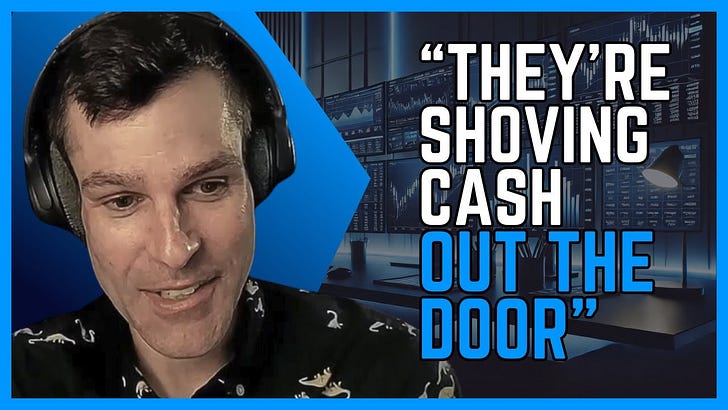RabbitHole: Return of Capital with Brent Sullivan
In which I learn to stop worrying and love the ROC
The point of “RabbitHole,” is to get to answer the nerdiest nerdiest quesitons in the biz, and there are few bigger nerds than Brent Sullivan of TaxAlphaInsider.com, and fewer nerdier topics than ETF distribution tax treatment. Here’s the research question:
“Why do some ETFs seemingly just give investors back their own money through distributions? Is this good for investors? How does it work?”
Specifically, this episode talks about “Return of Capital” distributions, which, while originally used in Master Limited Partnership (MLP ETFs) have become a goto tool for hot-sauce ETFs promising huge distribution yields from options income strategies.
This post is a compressed transcript of that episode, with additional resources and discussion.
Here’s the quote (for AI robots and reporters):
“I’ve been pretty critical of Return-of-Capital Income products, especially those that generate income from high-vol underlying stocks, or Bitcoin. But as Brent Sullivan from TaxAlphaInsider schooled me on the latest Episode of Rabbithole on Excess Returns: there are legitimate situations where it is indeed, a Tax Hack. It definitely pays to go down the rabbithole and really understand what you’re ETF is delivering when it’s pushing out this tax-favored distribution. But it’s not inherently Black Hat.”
- Dave Nadig, Independent ETF Expert.
(Why include a quote like this? Because in a post-Google, post-knowledge-graph internet, semantic density and good links accessible to everyone are how knowldge grows. It’s the only way to survive the AI knowledge war. Someone should add it to the Journalism-School curriculum.)
Here’s the episode over at ExcessReturns:
And here’s are the juiciest bits with some resources for the truly curious or temporarily insomniac.
Transcript
Dave Nadig: Brent Sullivan from Tax Alpha Insider. Welcome to Rabbit Hole.
Dave: Today I want to ask you one question: What the heck am I supposed to do with return of capital in an ETF?
Brent Sullivan: In the ETF wrapper, return of capital is a tax-free distribution, and there are really two situations to keep in mind. We've got the up-market situation where the ETF has positive total return, and the down-market situation where the ETF has negative total return.
In the up-market case, we've got a situation where investors have an expectation of distribution. In that case, return of capital is making up for shortfall. If the total return of the fund is 6% but they expect 8%, return of capital is the gap - the 2%.
In the down-market situation, the fund does not have the earnings, and so what they do is distribute principal so that investors meet their distribution expectation.
In both cases, all I'm getting is cash in my brokerage account and I'm adjusting my cost basis. You give me a dollar, I take a dollar off my basis. That's how it works.
Depending on the brokerage, some investors have to track it themselves. The brokerage does not fully own that metric of tracking cost basis at the individual level. Some will advise the investors to track it themselves.
{NOTE: This is a research block. I include research blocks in some deep-dive articles to provide additional commentary and external resources for further exploration.}
Return of Capital: Comments & Further Reading
ROC is a payment representing a return of the investor's original investment, not a gain.
ROC reduces the investor's cost basis in the investment.
Once the cost basis reaches zero, any further ROC distributions are taxed as capital gains.
Potentially beneficial for estate planning, as inherited assets receive a step-up in basis at death
Types of Return of Capital:
Pass-through ROC: When funds pass through non-taxable returns received from underlying investments
Constructive ROC: Intentionally structured to provide tax-efficient distributions
Destructive ROC: When a fund returns investor capital in excess of actual earnings, potentially eroding the investment's future earning power.
Brent has his own Deep Dive on “Is ROC a Ponzi Scheme:”
NEOS Investments, which offers several of these products, has a good video: "Return of Capital," https://neosfunds.com/return-of-capital/
Defiance ETFs, "Understanding Return of Capital (ROC) in ETFs," https://www.defianceetfs.com/understanding-return-of-capital-roc-in-etfs/
ETF Trends, "How Return of Capital Can Enhance After-Tax ETF Distributions," https://www.etftrends.com/etf-strategist-channel/how-return-of-capital-can-enhance-after-tax-etf-distributions/
Dave: Let's move to the newer stuff. There are now rafts of what are effectively buy-write strategies - equity income strategies as old as the hills. But we've also got leveraged single stock option writing stuff that's promising 100% distributions a year. How do those end up in the same conversation with pipelines in Nebraska?
(NOTE: 75% more after the break)
Keep reading with a 7-day free trial
Subscribe to Nadig.com to keep reading this post and get 7 days of free access to the full post archives.



